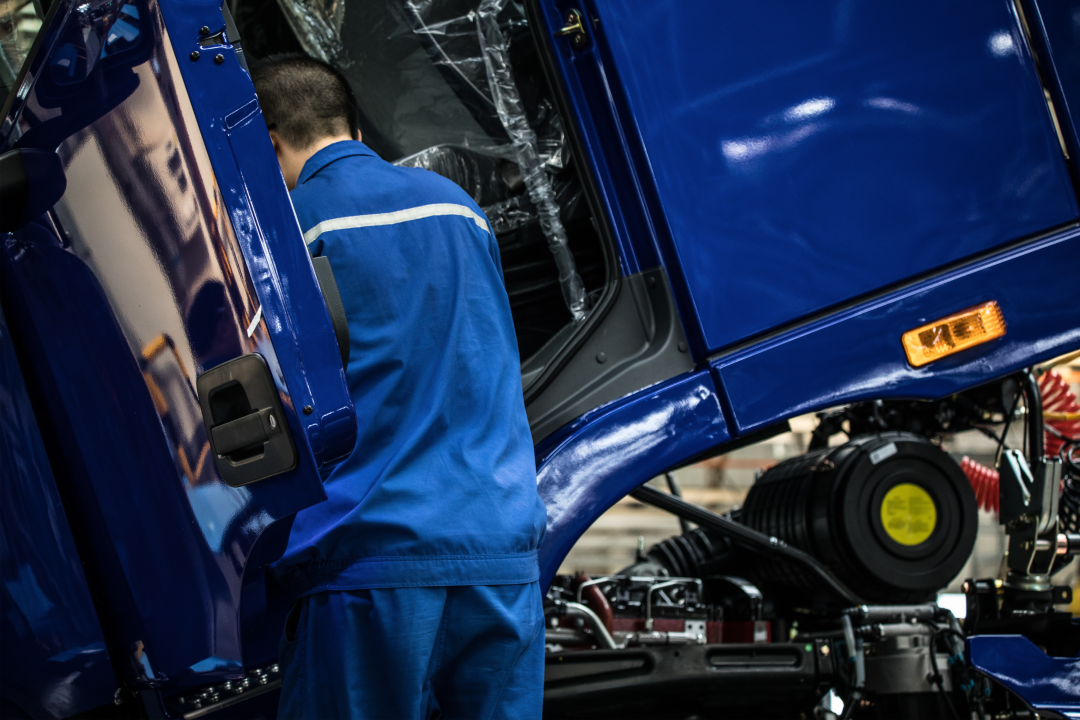
Susie Jones
Водії-далекобійники з інвалідністю - яка підтримка доступна?
Створено: 12.08.2024
•
Оновлено: 12.08.2024
У Великій Британії [23%] (https://commonslibrary.parliament.uk/research-briefings/cbp-7540/#:~:text=There%20were%209.58%20million%20people,of%20the%20working%2Dage%20population.) працездатного населення повідомили, що вони мають інвалідність - невідомо для багатьох, що значна частина з них - водії вантажівок, які нескінченно подорожують Європою, щоб доставити ваші вантажі. Незважаючи на те, що вони стикаються з багатьма проблемами, їхня присутність у спільноті вантажоперевізників підкреслює важливість інклюзії та різноманітності в галузі.
Якщо у мене інвалідність, чи можу я керувати вантажівкою?
Якщо у вас фізична або когнітивна інвалідність, ви можете керувати великовантажним автомобілем. Однак ви повинні пройти медичний огляд, щоб визначити, чи достатньо ви придатні для цього. Медичний огляд складається з наступного:
Розмова з лікарем про стан вашого здоров'я: Водії повинні бути чесними та відкритими.
Фізичний огляд, під час якого лікар перевірить вас:
Артеріальний тиск
Серце
Бачення
Тест на діабет
Неврологічні захворювання
Розлади сну.
Після завершення DVLA вирішить, чи можете ви керувати автомобілем.
Пристосування вантажівки
Для водіїв з обмеженими фізичними можливостями доступні наступні модифікації:
Ручне управління замість педалей
Допоміжні засоби рульового управління
Прискорювачі для лівої ноги
Переобладнання зчеплення
Ремені безпеки
Спеціалізовані місця для сидіння
Обладнання для зберігання інвалідних візків.
У 2021 році виробник вантажівок MAN адаптував чотири [вантажівки для водіїв з інвалідністю] (https://trans.info/check-out-the-lorries-man-altered-to-accommodate-disabled-drivers-228342). Адаптація включала оснащення вантажівок підйомною платформою, щоб люди в інвалідних візках могли легко дістатися до кабіни - з усіма елементами управління, встановленими на кермі або навколо нього.
Незважаючи на розвиток технологій та адаптації в галузі, багато водіїв з інвалідністю все ще стикаються з проблемами на роботі.

З якими перешкодами стикаються водії вантажівок з інвалідністю?
Водіям з інвалідністю може бути складно потрапити на роботу, навіть якщо вони мають необхідну кваліфікацію та пройшли медичний огляд. Багато компаній неохоче надають пристосовані транспортні засоби, оскільки це може бути дорогою інвестицією.
Енді, генеральний директор благодійної організації [Globe Truckers UK] (https://www.globetruckersuk.org/), стверджує, що водіям, які готові платити за необхідні адаптації, все ще складно знайти роботу.
"Деякі транспортні компанії неохоче беруть на роботу людей з інвалідністю - вони часто остерігаються перешкод, з якими водії стикаються за межами кабіни, наприклад, сходів і підйомів".
Девід Чемберс, [водій вантажівки з інвалідністю] (https://www.disabilitynewsservice.com/disabled-hgv-driver-accuses-back-to-work-ministers-of-hypocrisy-over-equality-laws/), виступив проти випробувань, з якими він стикається щодня, і закликав внести розумні корективи до Закону про рівність - особливо після того, як уряд закликав більше людей, які отримують допомогу по інвалідності, [повернутися на роботу] (https://www.disabilityrightsuk.org/news/chancellor-announces-back-work-plan-disabled-people-backed-tougher-sanctions#:~:text=Forming%20part%20of%20his%20Autumn,for%20and%20stay%20in%20work.).
Девіду та багатьом іншим доводиться нелегко на великих автобазах, де, згідно з [Законом про рівність] (https://www.legislation.gov.uk/ukpga/2010/15/contents), автобаза не зобов'язана робити розумні пристосування для водіїв з інвалідністю. З міркувань безпеки їм доводиться чекати на розвантаження далеко від своїх вантажівок, що призводить до необхідності долати великі відстані та підніматися сходами.
Яка підтримка існує для водіїв вантажівок з інвалідністю?
Пошук підтримки може бути важким для тих, хто отримав травму або хворобу, що змінює життя. Британська благодійна організація Globe Truckers була створена водіями спеціально для того, щоб допомагати водіям - надавати підтримку пораненим, хворим чи інвалідам.
"Багато водіїв з інвалідністю або травмами не знають, куди звернутися, оскільки інформації для них дуже мало. Саме тут ми приходимо на допомогу і пропонуємо свою підтримку та поради - чи то скерувати до потрібних людей, чи надати фінансування на обладнання".
"Деяким водіям просто потрібно з кимось поговорити, і ми тут, щоб запропонувати їм будь-яку можливу підтримку. У майбутньому ми хотіли б мати можливість фінансувати адаптацію вантажівок для водіїв. Адаптація може бути дуже дорогою, і більшості водіїв з інвалідністю доводиться платити за неї з власної кишені. Щоб досягти цього, нам потрібно більше фінансування та підтримки від тих, хто працює в цій галузі", - стверджує Енді.
Як індустрія може допомогти?
Для більш інклюзивного та різноманітного ландшафту індустрія повинна докладати більше зусиль, щоб пристосуватися до фізичних та когнітивних порушень - зміни мають відбутися найближчим часом, каже Енді.
"Життєво важливо, щоб галузь повертала свою підтримку та час назад у себе, чи то безпосередньо водіям з інвалідністю, чи то благодійним організаціям, таким як Globe Truckers. Галузь не може розраховувати на довіру людей, якщо вона не надає підтримку меншинам".
Будучи притулком для багатьох водіїв, зупинки вантажівок можуть прокласти шлях, забезпечивши доступні зручності. У 2022 році уряд інвестував 100 мільйонів фунтів стерлінгів у цю галузь, щоб покращити придорожні об'єкти та створити безпечніші стоянки для вантажівок.

Державне фінансування могло б покращити доступність для водіїв з інвалідністю на популярних зупинках. Суттєвий вплив можуть мати такі зміни, як наведені нижче:
Паркувальні місця для інвалідних візків: водіям, яким важко сідати і виходити з кабіни, потрібен додатковий простір - особливо для тих, кому потрібен підйомник.
Доступні зручності: доступні ресторани, туалети та інші об'єкти забезпечують інклюзивне середовище.
Автотранспортні компанії можуть допомогти у створенні більш інклюзивного середовища, впровадивши наступні заходи:
Модифікація вантажівок - полегшення керування для водіїв з обмеженими можливостями за допомогою ручного керування та адаптивних технологій.
Підтримка та навчання - проведення курсів для вирішення конкретних проблем або потреб.
Інклюзивні практики найму - неупереджений підхід при прийомі на роботу сприяє розвитку інклюзивної та різноманітної культури.
Забезпечення різноманітної та інклюзивної культури є життєво важливим для залучення більшої кількості водіїв у галузь перевезень. Підтримка людей з фізичними та когнітивними порушеннями залишається поза увагою галузі, тому багато водіїв не знають, куди їм звертатися. Водії з інвалідністю пропонують унікальну точку зору та адаптивність, що є позитивною зміною для галузі
Що робити, якщо ви стали інвалідом під час своєї кар'єри?
Якщо у вас розвивається "підлягаючий повідомленню" стан здоров'я або інвалідність, ви повинні повідомити про це DVLA - DVLA зробить наступне:
Прийміть рішення в листі - за певних обставин може знадобитися більше інформації.
Оцініть свій стан здоров'я та вирішіть, яким буде результат.
Якщо вам потрібно адаптувати свій транспортний засіб, вам знадобиться незалежна оцінка вашої [адаптації] (https://www.drivingmobility.org.uk/).
Якщо ви повинні припинити водіння, DVLA надасть вам медичну причину для цього.



